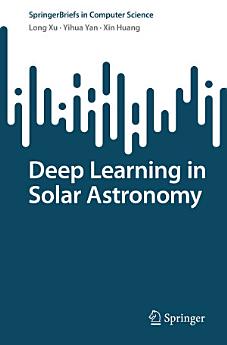About this ebook
Astronomical study starts with imaging from recorded raw data, followed by image processing, such as image reconstruction, inpainting and generation, to enhance imaging quality. We study deep learning for solar image processing. First, image deconvolution is investigated for synthesis aperture imaging. Second, image inpainting is explored to repair over-saturated solar image due to light intensity beyond threshold of optical lens. Third, image translation among UV/EUV observation of the chromosphere/corona, Ha observation of the chromosphere and magnetogram of the photosphere is realized by using GAN, exhibiting powerful image domain transfer ability among multiple wavebands and different observation devices. It can compensate the lack of observation time or waveband. In addition, time series model, e.g., LSTM, is exploited to forecast solar burst and solar activity indices.
This book presents a comprehensive overview of the deep learning applications in solar astronomy. It is suitable for the students and young researchers who are major in astronomy and computer science, especially interdisciplinary research of them.
About the author
Prof. Yihua Yan received his Ph.D. degree from the Dalian University of Technology in 1990. He was a Foreign Research Fellow with the NAOJ (Japan) from 1995 to 1996, and an Alexander von Humboldt Fellow with the Astronomical Institute, Wurzburg University, Germany, from 1996 to 1997. He was the President of IAU Division E: Sun and Heliosphere from 2015 to 2018. He was the Director of the CAS Key Laboratory of Solar Activity (2008-2019), and the Director of Solar Physics Division (2013-2021), at NAOC. He is currently a Professor and a Chief Scientist, National Space Science Center, Chinese Academy of Sciences.
Dr. Xin Huang received the Ph.D. degree from Harbin Institute of Technology in 2010. He was an associate professor at Solar Activity Prediction Center, NAOC from 2013. Now, he is with the Space Environment Prediction Center, National Space Science Center, Chinese Academy of Sciences. His research interests include data mining, image processing and short-term solar activity forecasting. He has published more than 20 academic papers, including one of the top 1% most cited papers in IOP Publishing’s astrophysics journals, published over the period of 2018-2020.




